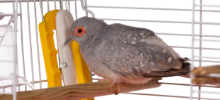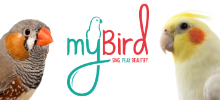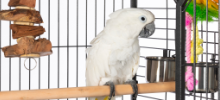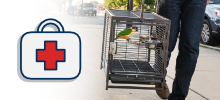Birds
Bird Sizes
It's important to understand your bird's size and what cages, toys, and accessories are appropriate for them. We've assembled this sizing information to help you more easily stay informed about what's best for your bird!



BIRD SPECS:
- Length: 4"–7" (beak to tail)
- Types: Finch, Sparrow
- Wire Spacing: 3/8"–7/16"
- Wire Gauge: 18–13

BIRD SPECS:
- Length: 7"–10" (beak to tail)
- Types: Canary, Parakeet
- Wire Spacing: 3/8"–1/2"
- Wire Gauge: 18–13

BIRD SPECS:
- Length: 10"–13" (beak to tail)
- Types: Parakeet, Lovebird, Cockatiel
- Wire Spacing: 3/8"–5/8"
- Wire Gauge: 18–13

BIRD SPECS:
- Length: 13"–18" (beak to tail)
- Types: Cockatiel, Conure, Small Parrot
- Wire Spacing: 1/2"–3/4"
- Wire Gauge: 12–8

BIRD SPECS:
- Length: 18"–24" (beak to tail)
- Types: Amazon, African Grey
- Wire Spacing: 3/4"–1"
- Wire Gauge: 12–8

BIRD SPECS:
- Length: 24"–40+" (beak to tail)
- Types: Cockatoo, Macaw
- Wire Spacing: 1"–1-1/2"
- Wire Gauge: 12–8
Bird Care
Birds are one of the most beautiful, entertaining and unique animals in the world. Each one, each species has a personality all its own. Before selecting a specific species of bird on your own, talk to a local bird specialist, veterinarian or hobbyist to determine what type of bird is best suited to you and your family. Many hobbyist periodicals and bird books are also available to do your own research.
Once you have made your selection, seek out a licensed veterinarian skilled in bird medicine who will take care of your bird on a regular basis. This professional will not only help maintain the bird's health, but will routinely groom the bird by trimming the nails, beak and wings.
Once you have made your selection, seek out a licensed veterinarian skilled in bird medicine who will take care of your bird on a regular basis. This professional will not only help maintain the bird's health, but will routinely groom the bird by trimming the nails, beak and wings.
Be sure your bird has plenty of shade and is far enough away from any potentially hazardous fumes. Always keep bird out of reach of other pets as well as small children.
Keep your bird entertained and it will entertain you. After 2 weeks in the new cage, gradually add play-things. Prevent overcrowding by keeping to a minimum the number of toys in the cage at one time. Rotate the toys for variety.
By chewing and rubbing this helps keep the beak from overgrowing and provides essential calcium. Always keep a cuttlebone in the cage.
Keeping the cage clean helps prevent disease as well as freeing your bird from dirt and oil. Wash water and food cups daily, using a mild dish-washing detergent applied with a soft cloth or soft bristle brush.
Birds enjoy bathing, do it often. It's also necessary to keep their feathers in good shape. Use a cage-mounted bird bath. It is also a good idea to "mist" your bird frequently using a hand-held, spray-pump applicator.
Spring is generally molting season. As the bird loses its insulating feathers, keep the cage warm. Cover the cage for longer periods so your bird can sleep more during this stressful time.
MyBird Resources
From Amazon and African Grey to Conure and Canary, there are a wide variety of bird species. It's important to know about the traits and care required for each type of bird before investing in one as a pet.
Explore Bird Types
Explore Bird Types
Need some help? The MyRightBird quiz is designed to help you make an informed decision about what bird fits you and your lifestyle.
Take the Quiz!
Take the Quiz!
MyRightBird has a variety of resources to help you and your bird. Use their locator map tool to find birds, retailers, veterinarians, or bird clubs in your area.
Find Available Birds
Find Bird Retailers
Find Veterinarian Care
Find Regional Bird Clubs
Find Available Birds
Find Bird Retailers
Find Veterinarian Care
Find Regional Bird Clubs
Bird Cage Selection
A number of considerations are involved in the purchase of the "right" cage. Review the following topics to help guide you in the bird cage selection process.
- Should allow birds to comfortably spread wings
- Should have ample cage base depth for birds who do not sleep on perches
- Should have added cage height for climbing birds.
- Should provide ample room capacity for toys and related treats
- 3/8" suitable for finches and extremely small birds
- 1/2" general purpose for parakeets, canaries and all medium-sized birds.
- 5/8" suitable for cocktaiels, doves
- 1" suitable for all medium-to-large birds such as African greys.
- 1"+ suitable for macaws, cockatoos and other large birds.
- Vertical Bars: for Finches, Canaries, and All Climbers
- Horizontal Bars: for Parakeets, Parrots, Cockatiels, and All Climbing Species.
- Proper dowel diameter for species
- Proper hanging depth from top
- An appropriate size that will not over-crowd cage
- Possibility to be sturdily secured to top cage bars
- Seed guards
- Soft wood perches with proper accessibility to feeder cups
- Multiple feeder cups with ample holding capacity
- Sufficiently large doors for easy access and to accommodate bird's size
- A practical method of locking and securing doors
- In most cases, cost does dictate the amount of quality put into cage construction
- All plastic parts should have thick walls, especially in corner areas. Look for warpage and hairline cracks.
- Metal parts should not have any sharp edges. They should encompass solid multi-welds and should have an adequate application of plating or paint coverage.
- Generally speaking, all-steel constructed cages are preferable due to their longevity value and their ability to withstand more shock and cleaning than their plastic counterparts.
- Clear Lacquer: Should be applied to all plated parts for safety.
- Painted Finishes: Should always be baked on during the painting process.
- Non-Toxic: All epoxy liquid paint, epoxy powder coatings, and all plating finishes should be laboratory-tested to be child-safe and pet-safe. Lead-based coating materials should never be used.
- Plated & Powder-Coated Finishes: Easy-to-clean with a soft, damp cloth and immediately dry with a soft, dry cloth. Never use abrasive soaps or abrasive cleaning pads, and avoid cleanign with extremely hot water.
- Plated Finishes: Brass or nickel have a protective clear lacquer coating applied during the plating process. If this clear coating is worn off by excessive abrasive cleaning (or by years of use) the base plating will begin to oxidize. If oxidation does begin, you may need to replace the entire cage or — at a minimum — the part that is oxidizing.
- Painted Finishes: These should be baked on during the painting process. To avoid future rusting, immediately use touch-up paint on any chipped or scratched areas.
Emergency Evacuation
A quick and timely emergency evacuation requires advance preparation to ensure the safety and well-being of you and your bird. Prevue's Pet Experts have prepared a handy Emergency Evacuation checklist that you can read below or download and print HERE. Follow these essential steps to a safe, smooth exodus for you and your bird:
If you need to evacuate due to an emergency or natural disaster, ensure you have a destination where you and your bird will be welcome. Many evacuation shelters do not allow pets, so research pet-friendly hotels or temporary accommodations in advance.
Prepare a portable kit specifically for your bird. It should include the following items:
- Travel Carrier
Ensure the carrier is sturdy, secure, well- ventilated and appropriately sized for your bird. Choose a carrier that will work best with how you plan to travel. - Food & Water
Carry enough food and bottled water to last a few days. Bring familiar food that will be comforting during stressful situations. - Medications & First-Aid Supplies
Include any necessary medications for your bird and a basic first-aid kit. In the kit, include medical supplies for both you and the bird. - Cage Liners & Cleaning Supplies
Keep your bird's environment as clean and hygienic as possible. Having supplies on-hand will help reduce stress for you and your feathered friend. - Comfort Items
Bring your bird's favorite toys or items to help reduce stress during the evacuation. Having something to distract them during travel can help them stay more calm and comfortable. - Health Records & Identification
Include copies of medical records, ID tags and a recent photo of your bird. Also consider microchipping your bird if they are large enough. Talk to your vet to see if microchipping is the best option.
Gradually get your bird accustomed to its travel carrier well before any evacuation situation. Practice short trips to help your bird adjust to the carrier and reduce travel anxiety.
Determine how you will transport your bird during the evacuation. If you're driving, make sure the bird's carrier is securely fastened in the car, away from direct sunlight and drafts.
Keep an eye on local news and official sources for evacuation warnings and procedures. Always prioritize your safety and evacuate promptly when necessary.
Birds are sensitive creatures and may become stressed during an evacuation. Speak calmly and gently to your bird to provide reassurance during this time.
If you cannot bring your bird with you to your evacuation destination, arrange for temporary housing with a trusted friend, family member or a reputable boarding facility.
Ensure your bird is wearing an identification tag with your contact information. Also talk to your vet to see if microchipping is a safe option, as it can increase the chances of being reunited if you and your bird get separated.
Keep important contact numbers, including your avian veterinarian and local animal shelters, in your evacuation kit.
Conduct mock evacuation drills to familiarize yourself and your bird with the process. This practice will help both of you stay calmer during a real emergency.





